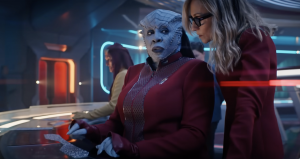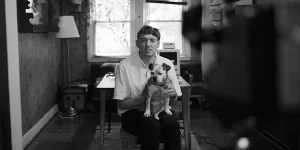
This article is presented by
For the musical staff at SpongeBob SquarePants, every morning begins with the potential to bring “The Best Day Ever.” That song was co-written by Andy Paley and the voice of SpongeBob, Tom Kenny. It debuted in the credits of the 2004 feature film, The SpongeBob SquarePants Movie, and captures the anticipatory joy of riding the Bikini Bottom wave.
“That is SpongeBob’s philosophy of life,” Kenny tells Den of Geek. “He jumps out of bed singing, ‘This is gonna be the best day ever.’ Sometimes it’s not. But he goes to bed and believes tomorrow is gonna be.”
The sentiment still reverberates because the songwriters craft lasting tunes. The sounds and music of the beloved animated series have broadened its appeal and prolonged its impact. As Paley explains, “We aim for two things: songs that can be enjoyed outside SpongeBob, and records that, if you’re in a car with your kids for eight hours, wouldn’t drive you crazy. Songs get short shrift on kids’ cartoons. We were like, ‘let’s write great songs.’”
Like the secret ingredient that makes Krabby Patties so delicious, the songs of SpongeBob contain a special spice: the Bikini Bottom denizens. “These songs are about characters,” Kenny says. “[Creator] Steve Hillenburg did the hard work of making those personalities. The characters are so strong they almost write themselves.”
Hillenburg was pleasantly surprised. “Originally, Steve didn’t envision the show having as much music,” music director Nicolas Carr says. “He wanted effects to punch the humor, but music lifted the show to another level.”
Geography influences musical identity, and if the location is a pineapple under the sea, local rhythms run deep. “Hillenburg knew that music would be as important as those flowers in the background,” Kenny recalls. “He said, ‘You know those old Betty Boop cartoons, those crazy Hawaiian records? I wish somebody still played like that.’”
SpongeBob’s musical team had deep roots in a number of genres. “Bikini Bottom is somewhere in Polynesia,” Carr explains. “So, there was always this Tiki motif. I gathered a trio, and we created our own version of wacky Hawaiian Tiki music. The guys I work with do a lot of Western swing, so the steel guitar became central to our sound.”
The pilot’s first musical interlude brought an essential component. Hillenburg was a big fan of ukulele music. “[SpongeBob composer] Sage Guyton plays a lot of it,” Paley says.
But the first time ukulele is heard on SpongeBob, it is strummed by an icon.
“Steve thought that Tiny Tim’s ‘Living in the Sunlight’ encapsulated this character’s personality: living in sunshine, having a wonderful time,” Kenny explains. “Tiny Tim was a total oddball in the world, the way SpongeBob is.”
The comparison came at a price.
“It cost a lot of money to license that song,” Carr says. “When I saw that, I thought, ‘I got to work on this show.’”
SpongeBob’s incidental music is just as distinctive as the songs. It only takes a few notes to know exactly what is happening with a taste of what’s to come. “Nick will weave together six tracks, and you won’t hear one change,” co-showrunner Vincent Waller says. “He’s a genius at making it not feel abrupt, even though moods change quickly.”
Carr, a veteran composer for shows such as Adventure Time, Camp Lazlo, and Rocko’s Modern Life, considers each episode of SpongeBob SquarePants a sonic blank slate. The colorful imagery informs the music, which then in turn complements the action again. Through it all, the humor begins to take on new life. The comedy comes from the unexpected as much as the familiar. Carr proudly boasts that he’s a “B-movie horror buff,” who “loves old corny soundtracks.” The team uses the APM and the Paramount music libraries. Only about 30 percent comes from his original music library.
Carr splices these disparate sonics into a unified sound that is unique, yet still emotionally recognizable. “When we do Mermaid Man and Barnacle Boy episodes, I harken back to the ’60s Batman TV show,” Carr says. “I add my own guys to put our spin on it. Then we find the right moment to cut it into the show.”
Some background music is neither melodic nor regulated by time signatures or keys, but by mood. “On occasion, when I see a scene, I’ll know I need an undulating vibraphone, with tremolo and echo,” Carr says. “I often throw in a little theremin, like the old sci-fi movies used to have.”
Carr does not chase after perfection because barnacles add character.
“I look for mistakes,” he says. “I like first takes—that’s the most honest performance. I’m a drummer, I play guitar, I can build it all up.”
Soon, noteworthy musicians came running to guest on the show. James Burton, Elvis Presley’s longtime guitarist, contributed to a handful of songs as did Flaco Jiménez, considered the most famous Mexican accordion player of all time. Paley, a longtime writing partner with the leader of The Beach Boys, even remembers bringing another legendary figure into the fold: “We had Brian Wilson on two different recordings, and one of our tracks is the last thing Tommy Ramone of The Ramones ever played drums on.”
Not only players but singers from every genre wanted to jam with the SpongeBob crew.
“Hillenburg was reaching out to musicians from the beginning,” Waller says. “Musicians who loved SpongeBob were reaching out to him. He definitely grabbed those reins and ran with them.”
Director and Spinal Tap guitarist Christopher Guest, Gene Simmons of KISS, The Cramps’ Lux Interior, The Spice Girls’ Victoria Beckham, and the metal band Pantera all booked Bikini Bottom studio time. “David Bowie and his kids liked the show,” Waller remembers. “He volunteered to do it. He didn’t require anything other than, ‘Send me the script.’”
The artists only have to bring their voices. “Most guests haven’t written the music,” co-showrunner Marc Ceccarelli says. “It’s either [composer] Ego Plum or Nick.” Guest vocals go through the SpongeBob process. “The episode’s writer does the lyrics and teams with a composer,” says Carr. “Showtune songs go to Eben Schletter. A mock-up with a rough vocal guides the artist, who sings to the demo. When it’s being animated, we refine the track.”
Even the theme song, “SpongeBob SquarePants,” is universally recognized as iconic. All across the world, the phrase, “Who lives in a pineapple under the sea?” engenders the correct response.
“It’s definitely iconic,” Paley confirms. “You can ask, ‘Who lives in a pineapple under the sea?’ and people know the answer.” The song often shows up in the least expected places, too. “I was watching a special on hardcore prisons,” Carr tells us, “and one place had inmates march to the SpongeBob song like a Marine chant.”
That’s more than a crossover hit. It proves the Bikini Bottom sound is a pop-culture phenomenon.
The post SpongeBob SquarePants: The Making of the Music of Bikini Bottom appeared first on Den of Geek.









